Creep and Shrinkage Behaviour of Disintegrated and Non-Disintegrated Cement Mortar
Abstract
:1. Introduction
2. Materials and Methods
2.1. Test Specimen Preparation
2.2. Experimental Setup
3. Results
4. Discussion
5. Conclusions
- Disintegration does not show activity regeneration in old cement. There is a less than 1% difference in the hydration temperatures of non-disintegrated old and disintegrated old cement mortars and these are 25.4% lower than that of non-disintegrated new cement mortar. This further confirms that one cycle of collision milling does not affect the chemical composition of old cement.
- Disintegrated old cement mortar shows a 31% higher compressive strength than non-disintegrated new cement mortar whereas non-disintegrated old cement mortar shows an 18% lower compressive strength than non-disintegrated new cement mortar.
- Shrinkage strain readings show 21.8% and 17.5% larger strains to non-disintegrated new cement mortar and old non-disintegrated cement mortar than disintegrated old cement mortar. It means that shrinkage can be reduced by having finer base material and therefore better packing in the mould. The hydration temperature in this case does not have a significant role.
- New non-disintegrated cement mortar shows a vastly lower amount of creep strain than disintegrated old and non-disintegrated cement mortar; 26% and 26.1% less, correspondingly. However, when the stress impact to strains is taken out, or, in other words, specific creep is calculated, the most significant reduction in specific creep value is to that of old disintegrated cement mortar, with 7% and 51% increases in specific creep in new non-disintegrated and old non-disintegrated cement mortars, respectively. This means that disintegration makes old cement mortar 51% less willing to creep than non-disintegrated cement mortar and 7% less willing to creep than new cement mortar.
- Together with XRD analysis, it is safe to conclude from our study that proper storage of cement does not significantly reduce its properties over a short period. The disintegration effect on material properties is more related to obtaining finer material with a higher specific surface area after milling than it had before disintegration. Applying disintegration to old cement does not regain its chemical activity but it does make cement significantly finer and therefore ensures better packing of the compound into moulds, which decreases porosity and other heterogeneities of elements.
Author Contributions
Funding
Institutional Review Board Statement
Informed Consent Statement
Data Availability Statement
Acknowledgments
Conflicts of Interest
References
- Dvořák, K.; Macháčková, A.; Ravaszová, S.; Gazdič, D. Effect of Imposed Shear Strain on Steel Ring Surfaces during Milling in High-Speed Disintegrator. Materials 2020, 13, 2234. [Google Scholar] [CrossRef] [PubMed]
- Singh, N.B.; Middendorf, B. Geopolymers as an alternative to Portland cement: An overview. Constr. Build. Mater. 2020, 237, 117455. [Google Scholar] [CrossRef]
- Edser, C. Reducing the environmental impact of laundry. Focus Surfactants 2005, 2005, 1–2. [Google Scholar] [CrossRef]
- Königsberger, M.; Carette, J. Validated hydration model for slag-blended cement based on calorimetry measurements. Cem. Concr. Res. 2020, 128, 105950. [Google Scholar] [CrossRef]
- Bumanis, G. Performance Evaluation of Cement Mortar and Concrete with Incorporated Micro Fillers Obtained by Collision Milling in Disintegrator. Ceram. Silik. 2017, 61, 231–243. [Google Scholar] [CrossRef] [Green Version]
- Kang, X.; Lei, H.; Xia, Z. A comparative study of modified fall cone method and semi-adiabatic calorimetry for measurement of setting time of cement based materials. Constr. Build. Mater. 2020, 248, 118634. [Google Scholar] [CrossRef]
- Liang, S.; Wei, Y. Methodology of obtaining intrinsic creep property of concrete by flexural deflection test. Cem. Concr. Compos. 2019, 97, 288–299. [Google Scholar] [CrossRef]
- Farah, M.; Grondin, F.; Alam, S.; Loukili, A. Experimental approach to investigate creep-damage bilateral effects in concrete at early age. Cem. Concr. Compos. 2019, 96, 128–137. [Google Scholar] [CrossRef]
- Boumakis, I.; DI Luzio, G.; Marcon, M.; Vorel, J.; Wan-Wendner, R. Discrete element framework for modeling tertiary creep of concrete in tension and compression. Eng. Fract. Mech. 2018, 200, 263–282. [Google Scholar] [CrossRef] [Green Version]
- Rossi, P.; Tailhan, J.-L.; Le Maou, F. Comparison of concrete creep in tension and in compression: Influence of concrete age at loading and drying conditions. Cem. Concr. Res. 2013, 51, 78–84. [Google Scholar] [CrossRef]
- Nastic, M.; Bentz, E.; Kwon, O.-S.; Papanikolaou, V.; Tcherner, J. Shrinkage and creep strains of concrete exposed to low relative humidity and high temperature environments. Nucl. Eng. Des. 2019, 352, 110154. [Google Scholar] [CrossRef] [Green Version]
- Ibragimov, R.; Fediuk, R. Improving the early strength of concrete: Effect of mechanochemical activation of the cementitious suspension and using of various superplasticizers. Constr. Build. Mater. 2019, 226, 839–848. [Google Scholar] [CrossRef]
- McDonald, D.B.; Weiss, W.J.; Al-Manaseer, A.A.; AChiorino, M.; Issa, M.A.; Rieder, K.A.; Bazant, Z.P.; Daye, M.A.; Marzouk, H.; Robertson, I.; et al. Report on Factors Affecting Shrinkage and Creep of Hardened Concrete. Concr. Int. 2005, 21, 1–12. [Google Scholar]
- Nizina, T.; Balykov, A. Experimental-statistical models of properties of modified fiber-reinforced fine-grained concretes. Mag. Civ. Eng. 2016, 62, 13–25. [Google Scholar] [CrossRef]
- Lee, N.; Jang, J.; Lee, H. Shrinkage characteristics of alkali-activated fly ash/slag paste and mortar at early ages. Cem. Concr. Compos. 2014, 53, 239–248. [Google Scholar] [CrossRef]
- Kuenzel, C.; Li, L.; Vandeperre, L.; Boccaccini, A.; Cheeseman, C. Influence of sand on the mechanical properties of metakaolin geopolymers. Constr. Build. Mater. 2014, 66, 442–446. [Google Scholar] [CrossRef]
- Zhang, J.; Ke, G.; Liu, Y. Experimental study on shrinkage reduction of calcium sulphoaluminate cement concrete with addition of pre-wetted lightweight aggregate. Constr. Build. Mater. 2020, 253, 119149. [Google Scholar] [CrossRef]
- Lee, K.-H.; Yang, K.-H.; Yoon, H.-S. Shrinkage strains of lightweight aggregate concrete using expanded bottom ash and dredged soil granules. Constr. Build. Mater. 2018, 188, 934–945. [Google Scholar] [CrossRef]
- Hua, J.; Huang, L.; Luo, Q.; Chen, Z.; Xu, Y.; Zhou, F. Prediction on the shrinkage of concrete under the restraints of steel plates and studs based on the capillary tension theory. Constr. Build. Mater. 2020, 258, 119499. [Google Scholar] [CrossRef]
- Acker, P.; Agullo, L.; Auperin, M.; Carol, I.; Carreira, D.J.; MRCatarino, J.; Chem, J.-C.; AChiorino, M.; WDougill, J.; Huet, C.; et al. Rilem tc 107-csp: Creep and shrinkage prediction models: Principles of their formation Recommendation Measurement of time-dependent strains of concrete. Mater. Struct. 1998, 31, 507–512. [Google Scholar]
- ASTM C 157/C 157M–03. Standard Test Method for Length Change of Hardened Hydraulic-Cement Mortar and Concrete. Annu. Book ASTM Stand. 2003, 4, 1–7.
- Hołowaty, J. New Formula for Creep of Concrete in fib Model Code 2010. Am. J. Mater. Sci. Appl. 2015, 3, 59–66. [Google Scholar]
- Bumanis, G.; Bajare, D. Compressive strength of cement mortar affected by sand microfiller obtained with collision milling in disinte-grator. Procedia Eng. 2017, 172, 149–156. [Google Scholar] [CrossRef]
- Dvořák, K.; Dolák, D.; Dobrovolný, P. The Improvement of the Pozzolanic Properties of Recycled Glass during the Production of Blended Portland Cements. Procedia Eng. 2017, 180, 1229–1236. [Google Scholar] [CrossRef]
- Dvořák, K.; Dolák, D.; Paloušek, D.; Čelko, L.; Jech, D. The Effect of the Wear of Rotor Pins on Grinding Efficiency in a High-speed Disintegrator. Mater. Sci. 2018, 24, 29–34. [Google Scholar] [CrossRef] [Green Version]
- Jocius, V.; Skripkiūnas, G. The Mechanism of Disintegration of Cement Concrete at High Temperatures. Constr. Sci. 2016, 18, 4–9. [Google Scholar] [CrossRef] [Green Version]
- Gailitis, R.; Sprince, A.; Pakrastins, L.; Sahmenko, G.; Kozlovskis, T. Drying Shrinkage Deformation Comparison Between Foam Concrete, Geopolymer Concrete, Disintegrated, and Non-disintegrated Cement Mortar. In Proceedings of the IOP Conference Series: Materials Science and Engineering; IOP Publishing: Bristol, UK, 2019; Volume 660, p. 012036. [Google Scholar]
- Fan, Y.; Niu, H.; Zhang, X. Impact of the properties of old mortar on creep prediction model of recycled aggregate concrete. Constr. Build. Mater. 2019, Volume 239, 117772. [Google Scholar] [CrossRef]
- Kou, S.; Poon, C.S. Enhancing the durability properties of concrete prepared with coarse recycled aggregate. Constr. Build. Mater. 2012, 35, 69–76. [Google Scholar] [CrossRef]
- Lv, Z.; Liu, C.; Zhu, C.; Bai, G.; Qi, H. Experimental Study on a Prediction Model of the Shrinkage and Creep of Recycled Aggregate Concrete. Appl. Sci. 2019, 9, 4322. [Google Scholar] [CrossRef] [Green Version]
- He, Z.-H.; Hu, H.-B.; Casanova, I.; Liang, C.-F.; Du, S.-G. Effect of shrinkage reducing admixture on creep of recycled aggregate concrete. Constr. Build. Mater. 2020, 254, 119312. [Google Scholar] [CrossRef]
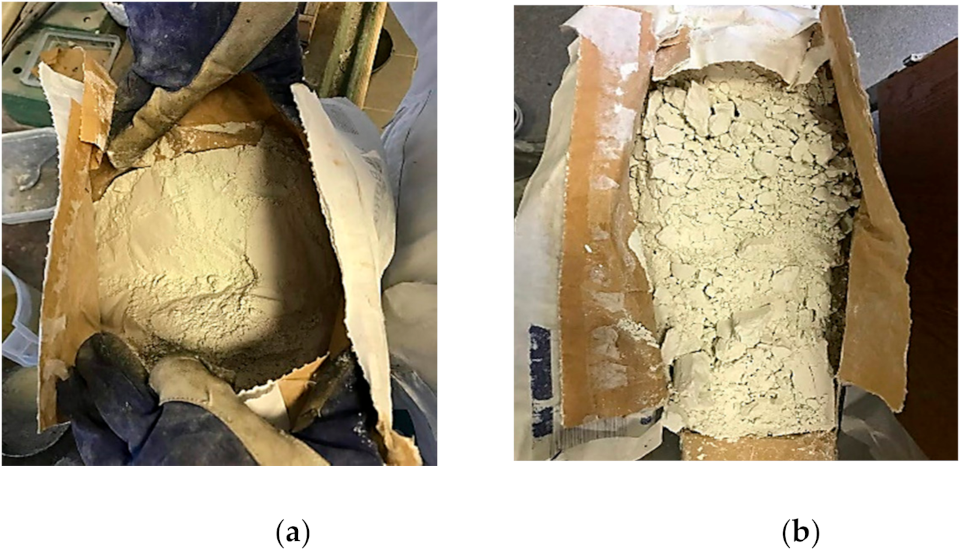

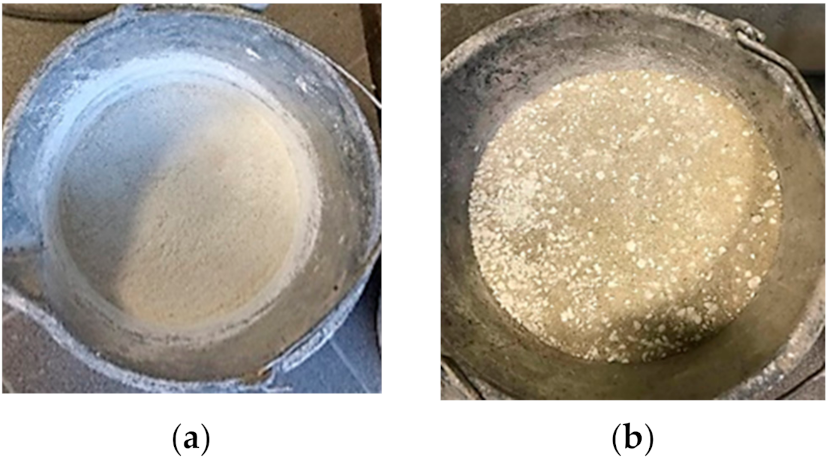
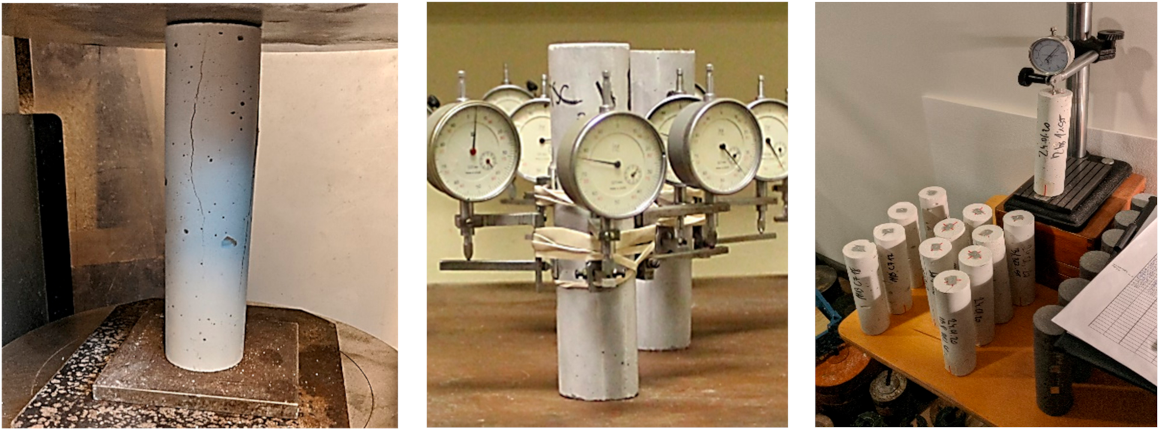
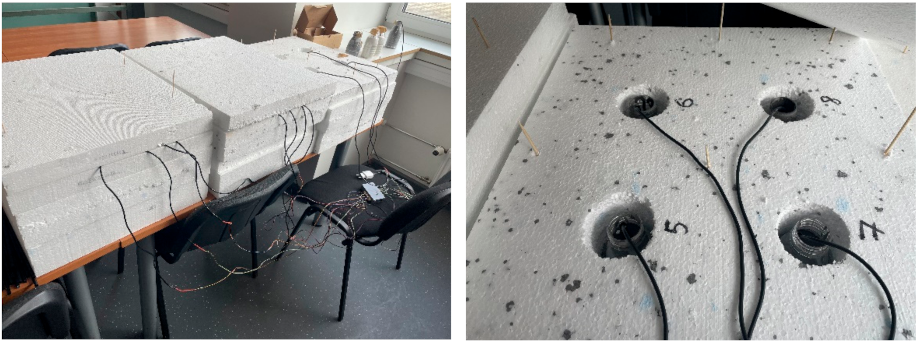
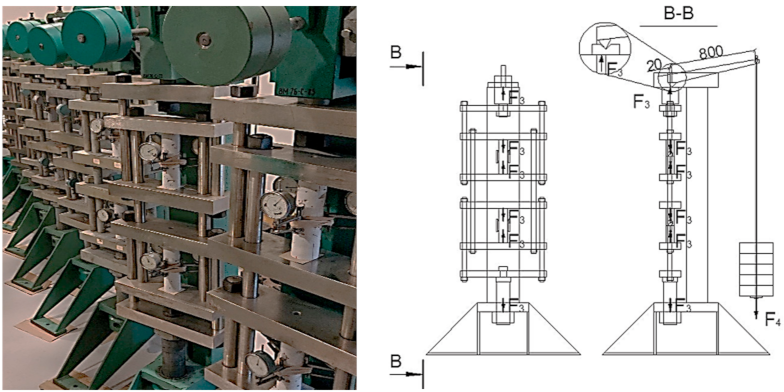
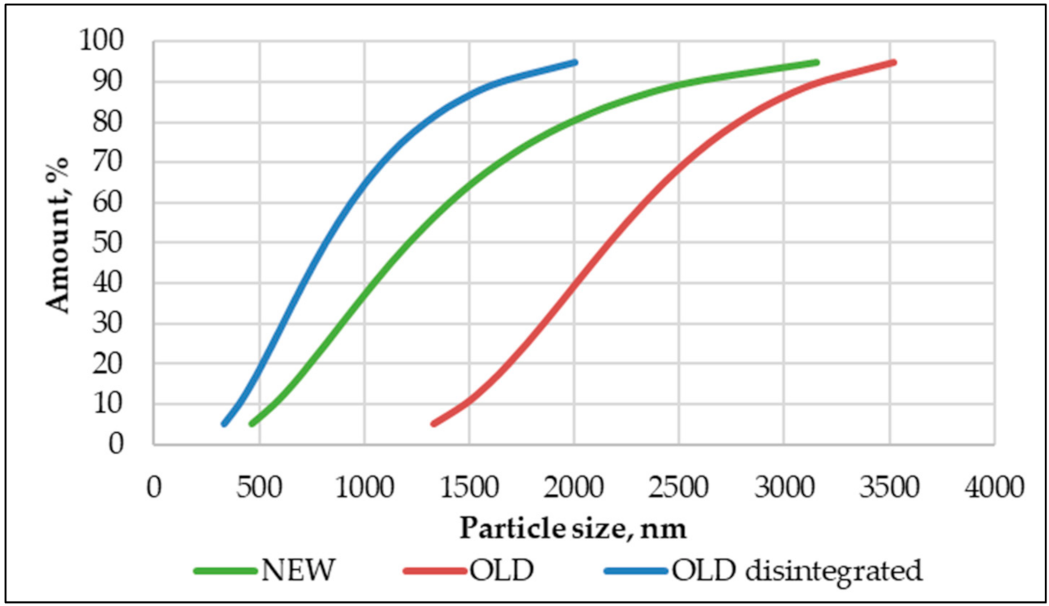
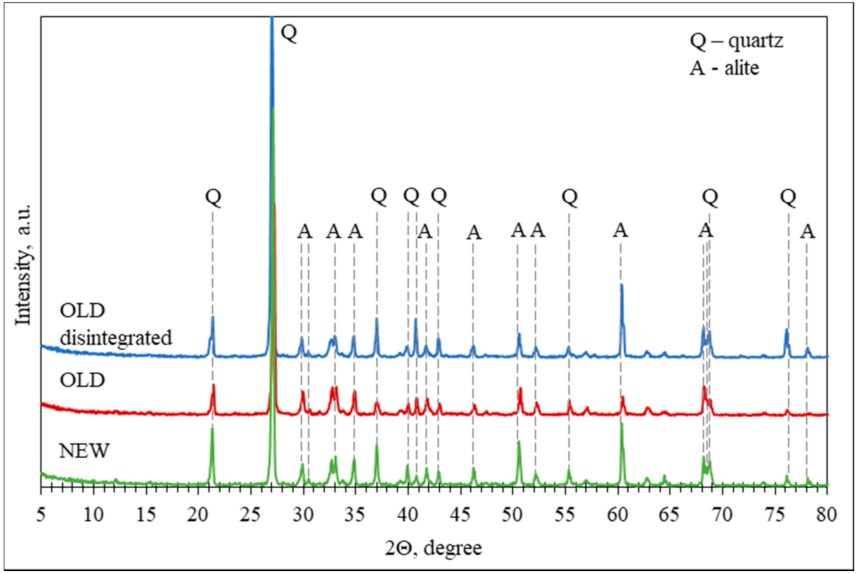
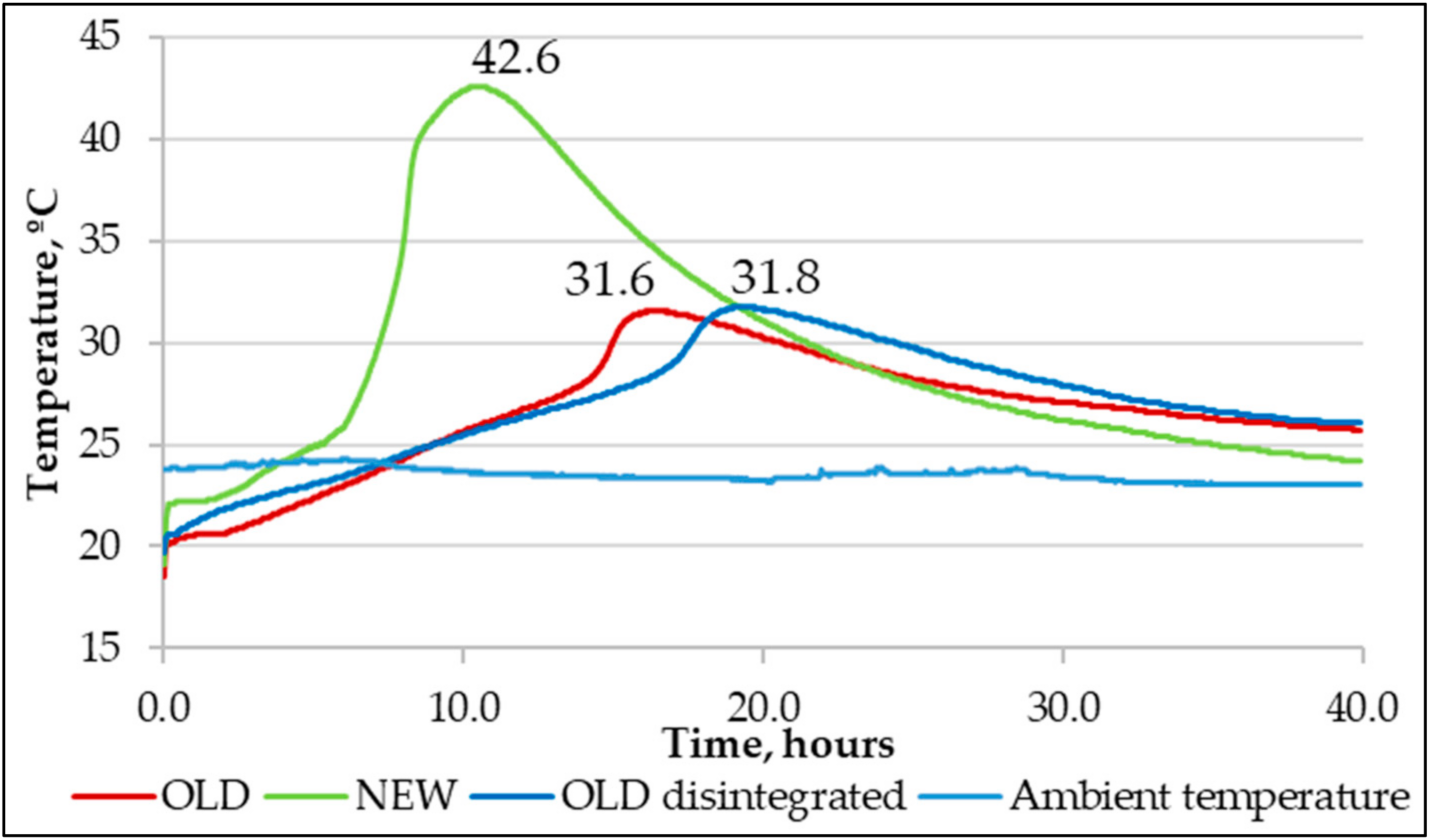
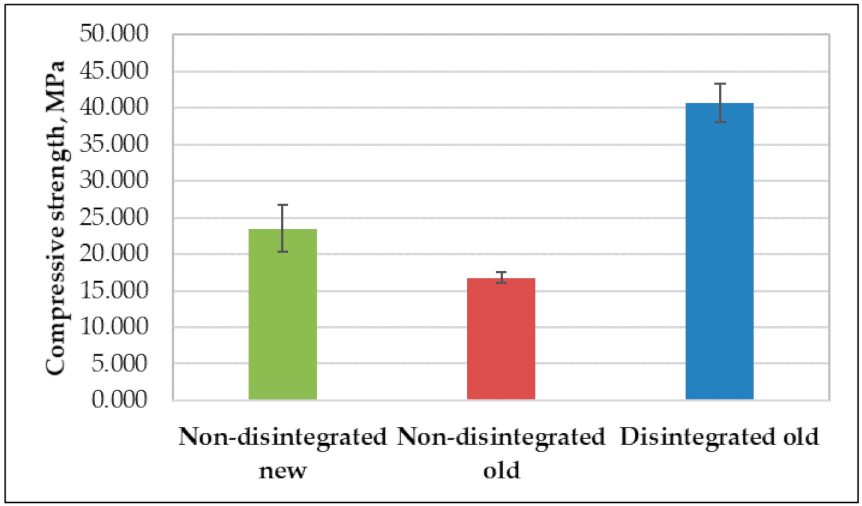
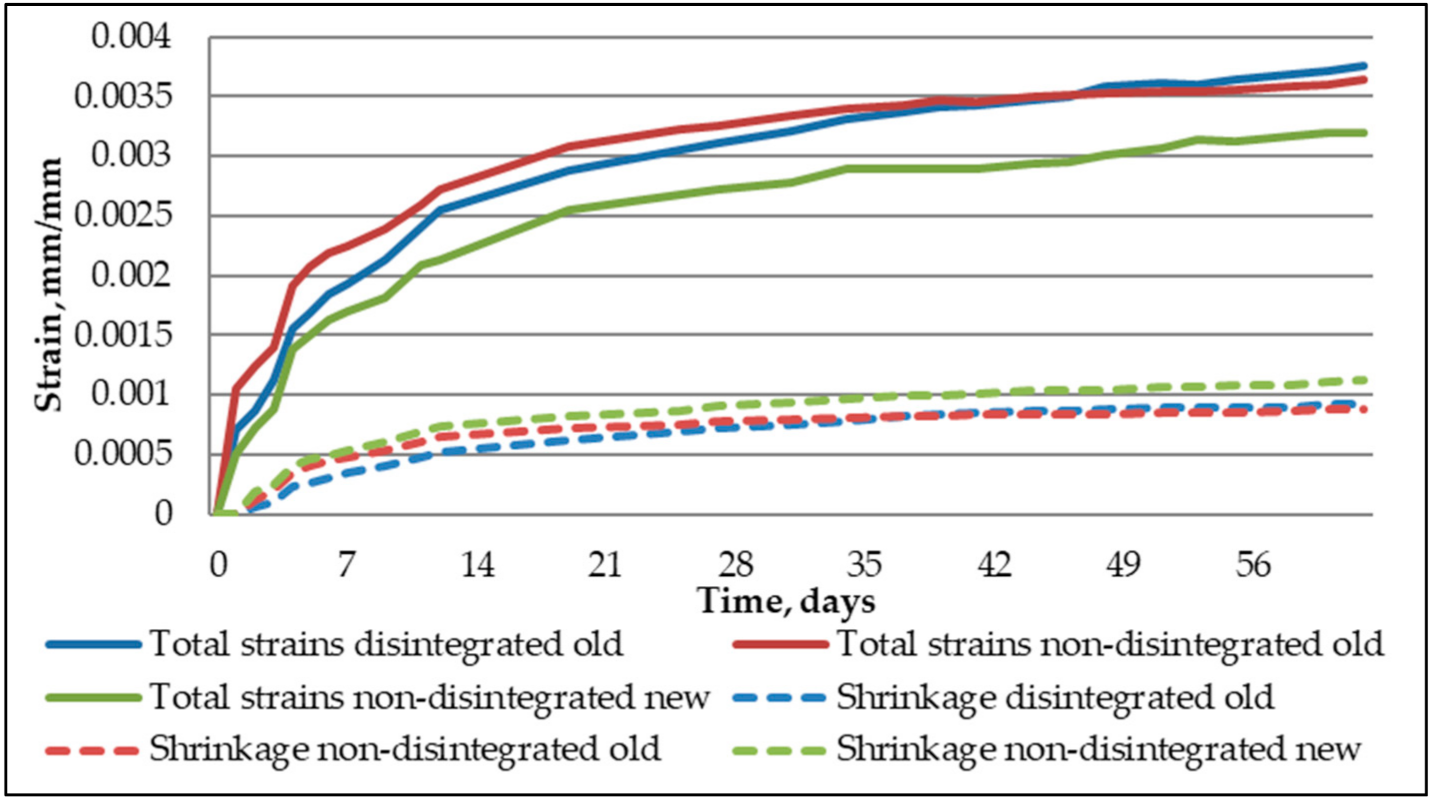
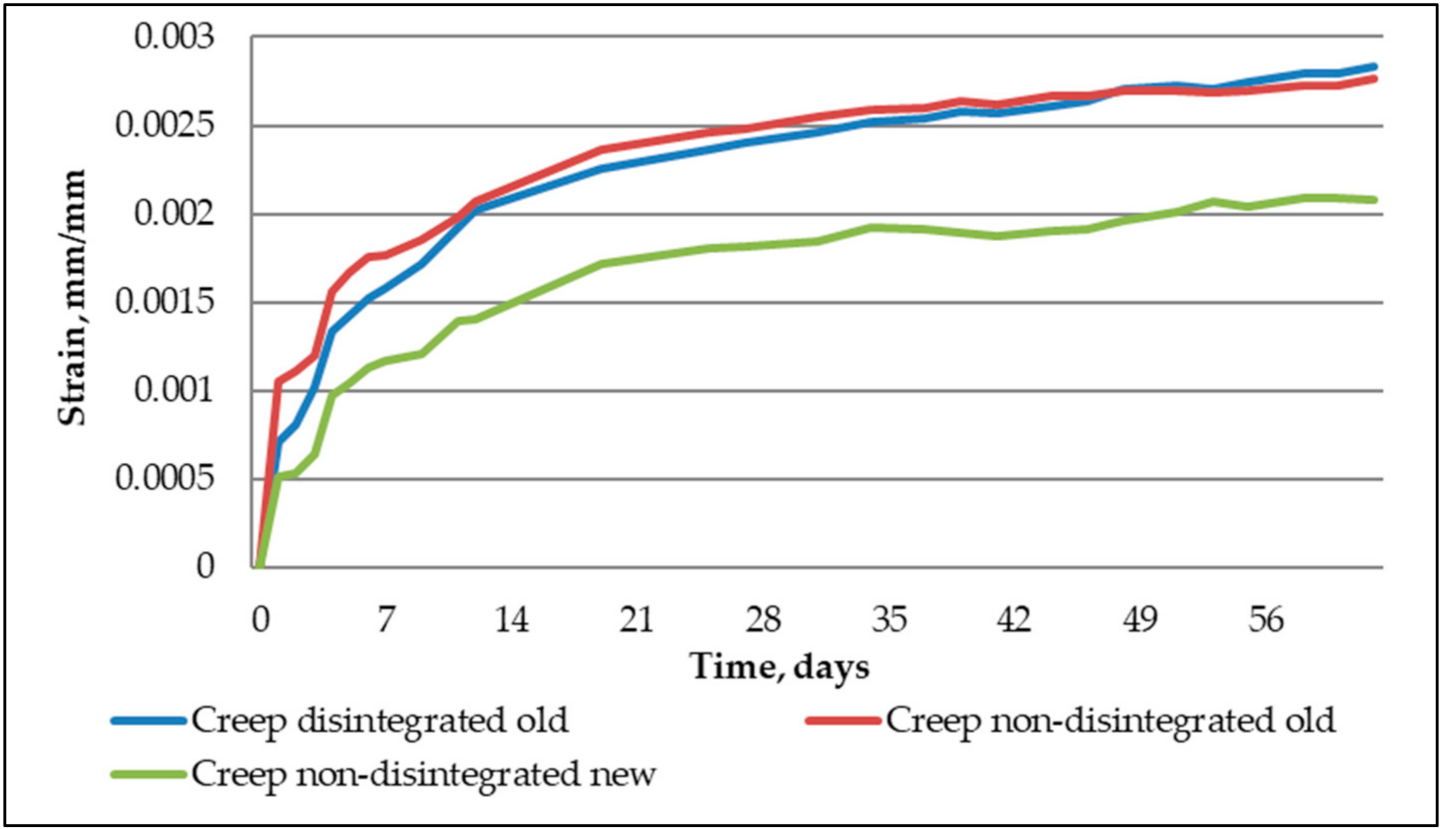

| Ingredients | Units | New Non-Disintegrated Cement Composite | Old Non-Disintegrated Cement Composite | Old Disintegrated Cement Composite |
|---|---|---|---|---|
| Mass Proportion | Mass Proportion | Mass Proportion | ||
| New cement CEM I 52.5R | kg/m3 | 1.0 | - | - |
| Old cement CEM I 52.5R | kg/m3 | - | 1.0 | - |
| Old disintegrated cement CEM I 52.5R | kg/m3 | - | - | 1.0 |
| Quartz sand 0.4/1 mm | kg/m3 | 1.75 | 1.75 | - |
| Quartz sand 0/0.5 mm | kg/m3 | 1.2 | 1.2 | - |
| Disintegrated quartz sand 0.4/1 mm | kg/m3 | - | - | 1.75 |
| Disintegrated quartz sand 0/0.5 mm | kg/m3 | - | - | 1.2 |
| Water | kg/m3 | 0.5 | 0.5 | 0.5 |
| Plasticizer Stachema | kg/m3 | 0.004 | 0.004 | 0.004 |
| W/C ratio C/S | - - | 1/2 1/3 | 1/2 1/3 | 1/2 1/3 |
| Mix Type | Average Mass, kg | Average Compressive Strength on Day 7, MPa | Average Density at the Age of 7 Days, kg/m3 |
|---|---|---|---|
| Non-disintegrated old | 0.3283 | 19.07 | 2136.95 |
| Disintegrated old | 0.3749 | 37.42 | 2453.43 |
| Non-disintegrated new | 0.2824 | 25.83 | 2171.79 |
| Materials | Results | Source | ||
|---|---|---|---|---|
| Creep Strains | Shrinkage Strains | Compressive Strength [MPa] | ||
| Non-disintegrated new cement mortar with sand | New cement mortar specimens showed vastly better creep properties, with 26 and 26.1% less than disintegrated and non-disintegrated old cement mortars. | The highest shrinkage occurred with new cement mortar, followed by old non-disintegrated and old disintegrated cement mortars correspondingly by 21.8 and 17.5% less. | Disintegrated cement mortar showed superior compressive strength over new cement and old cement non-disintegrated cement mortars by 31 and 49%, respectively. | |
| Non-disintegrated old cement mortar with sand | ||||
| Disintegrated old cement mortar with sand | ||||
| Cement, sand, water, natural aggregate concrete | Increasing the exchange of recycled coarse aggregate increased the basal and total creep deformation. The creep factor of old recycled aggregate concrete grew very quickly. | - | The best compressive strength was obtained for the sample with natural aggregate—40.2 MPa. Composites with recycled coarse aggregate achieved a compressive strength of 29 MPa, i.e., 27% less than the highest result. | [28] |
| Cement, sand, water, recycled coarse aggregate | ||||
| Portland cement, sand, fly ash, crushed granite, recycled aggregate | Concrete creep increased with increasing recycled aggregate content. The use of fly ash as a partial replacement reduced the creep kinetics of the concrete. | With the increase in the content of recycled aggregate, the shrinkage of concrete drying increased. The use of fly ash reduced shrinkage on drying in a blend with recycled aggregate to some extent. | The lowest strength was obtained for concrete with recycled coarse aggregate—19.4 MPa. On the other hand, the addition of crushed granite significantly increased the strength, by 43%. Thus, the recycled material can successfully fill in cement composites. | [29] |
| Portland cement, fly ash, sand, recycled aggregate | ||||
| Cement, natural coarse aggregate, fine aggregate | An increase in the replacement of recycled aggregate resulted in an increase in both creep and shrinkage of the material. It was related to the adhesion of the mortar. | The development of the shrinkage kinetic of mortar partially made of recycled grout increased by 25% and 48%, respectively, for the 50% and 100% substitute. | The addition of recycled coarse aggregate slightly reduced the compressive strength of the cement composite (by 7%), compared with concrete containing natural aggregate. | [30] |
| Cement, recycled coarse aggregate, fine aggregate | ||||
Publisher’s Note: MDPI stays neutral with regard to jurisdictional claims in published maps and institutional affiliations. |
© 2021 by the authors. Licensee MDPI, Basel, Switzerland. This article is an open access article distributed under the terms and conditions of the Creative Commons Attribution (CC BY) license (https://creativecommons.org/licenses/by/4.0/).
Share and Cite
Gailitis, R.; Figiela, B.; Abelkalns, K.; Sprince, A.; Sahmenko, G.; Choinska, M.; Guigou, M.D. Creep and Shrinkage Behaviour of Disintegrated and Non-Disintegrated Cement Mortar. Materials 2021, 14, 7510. https://doi.org/10.3390/ma14247510
Gailitis R, Figiela B, Abelkalns K, Sprince A, Sahmenko G, Choinska M, Guigou MD. Creep and Shrinkage Behaviour of Disintegrated and Non-Disintegrated Cement Mortar. Materials. 2021; 14(24):7510. https://doi.org/10.3390/ma14247510
Chicago/Turabian StyleGailitis, Rihards, Beata Figiela, Kalvis Abelkalns, Andina Sprince, Genadijs Sahmenko, Marta Choinska, and Martin Duarte Guigou. 2021. "Creep and Shrinkage Behaviour of Disintegrated and Non-Disintegrated Cement Mortar" Materials 14, no. 24: 7510. https://doi.org/10.3390/ma14247510
APA StyleGailitis, R., Figiela, B., Abelkalns, K., Sprince, A., Sahmenko, G., Choinska, M., & Guigou, M. D. (2021). Creep and Shrinkage Behaviour of Disintegrated and Non-Disintegrated Cement Mortar. Materials, 14(24), 7510. https://doi.org/10.3390/ma14247510







